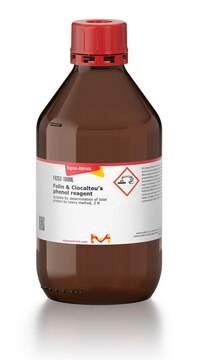49825
DMACA Reagent
suitable for microbiology
Sinónimos:
4-(Dimethylamino)-cinnamaldehyde solution
About This Item
Productos recomendados
technique(s)
microbe id | specific enzyme detection: suitable
Quality Level
application(s)
agriculture
environmental
food and beverages
microbiology
suitability
Escherichia coli
Streptococcus spp.
SMILES string
[H]C(=O)\C=C\c1ccc(cc1)N(C)C
InChI
1S/C11H13NO/c1-12(2)11-7-5-10(6-8-11)4-3-9-13/h3-9H,1-2H3/b4-3+
InChI key
RUKJCCIJLIMGEP-ONEGZZNKSA-N
General description
Application
Components
Dimethylaminocinnamaldehye 1 g
Hydrochloric acid (concentrated) 1.0 ml
distilled water 99.0 ml
Other Notes
signalword
Warning
hcodes
pcodes
Hazard Classifications
Met. Corr. 1
Storage Class
8B - Non-combustible corrosive hazardous materials
wgk_germany
WGK 2
flash_point_f
Not applicable
flash_point_c
Not applicable
ppe
Faceshields, Gloves, Goggles
Elija entre una de las versiones más recientes:
¿Ya tiene este producto?
Encuentre la documentación para los productos que ha comprado recientemente en la Biblioteca de documentos.
Artículos
Sigma-Aldrich.com presents an article concerning Differentiation of Escherichia coli from coliforms.
Nuestro equipo de científicos tiene experiencia en todas las áreas de investigación: Ciencias de la vida, Ciencia de los materiales, Síntesis química, Cromatografía, Analítica y muchas otras.
Póngase en contacto con el Servicio técnico
